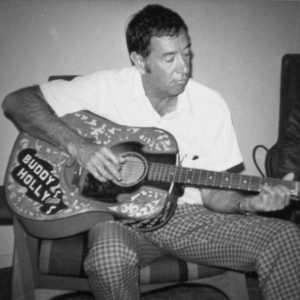Merle Haggard

The word “legend” usually makes an appearance at some point when discussing Merle Haggard. It’s an acknowledgment of his artistry and his standing as “the poet of the common man”. It’s a tribute to his incredible commercial success and to the lasting mark he has made, not just on country music, but on American music as a whole. It’s apt in every way but one.
The term imposes an aura of loftiness that’s totally at odds with the grit and heart of Haggard’s songs. “I’d be more comfortable with something like professor”, he once told a reporter, and the description suits him. Studying, analyzing and observing the details of life around him, Haggard relays what he sees, hears and feels through his songs. The lyrics are deceptively simple, the music exceptionally listenable. Others who have lived through those same situations recognize the truth in the stories he tells. But Haggard’s real gift is that anyone who hears his songs recognizes the truth in them. When a Merle Haggard song plays, it can make an innocent-as-apple-pie grandma understand the stark loneliness and self-loathing of a prisoner on death row; a rich kid who never wanted for any material possession get a feel for the pain of wondering where the next meal will come from; a tee-totaling pillar of the community sympathize with the poor heartbroken guy downing shots at the local bar.
As a result, Haggard found his songs at the top of the charts on a regular basis. Immediately embraced by country fans, he also earned the respect of his peers. In addition to the 40 #1 hits included here, Haggard charted scores of Top Ten songs. He won just about every music award imaginable, both as a performer and as a songwriter, and in 1994 was inducted into the Country Music Hall of Fame. His body of work easily places him beside Hank Williams as one of the most influential artists in country music.
That’s quite an accomplishment for the boy who was once officially branded “incorrigible”.
Merle Ronald Haggard was born in 1937, outside Bakersfield, California. His parents, Jim and Flossie, moved the family there after their farm in Oklahoma burned down, with Jim finding work as a carpenter for the Santa Fe Railroad. The family lived in an old boxcar that they converted into a home. Though struggling to make a meager living, they had a sturdy shelter and food was always on the table.
Things changed dramatically after Jim died of a stroke when Merle was nine years old. It was a devastating event for the young boy, who was very close to his father. His mother went to work as a bookkeeper to make ends meet, often leaving Merle in the care of a great aunt and uncle. With his world turned upside down, Haggard turned rebellious. He hopped a freight train when he was just ten years old, making it to Fresno before being picked up by the authorities. It was the first step toward a youth of truancy from school and petty crime. For the next few years, Haggard would find himself in reform schools, sometimes making an escape, only to get thrown back in again.
The angel on his shoulder during these troubled times was Haggard’s love and talent for music. Though he gave it up before Merle was born, his father used to play fiddle and guitar in Oklahoma for schoolhouse dances and social gatherings. Not having an automobile or formal instrument cases, the senior Haggard would ride his horse to these gatherings, carrying his fiddle on one side of the horse and the guitar on the other, in large pillowcases.
Still some of the musical gift had been passed on to Merle, and he easily took to playing guitar. Starting out as a fan of Bob Wills, Haggard eventually found his musical idol in Lefty Frizzell, and worked up a pretty impressive copy of the original’s singing style. “For three or four years I didn’t sing anything but Lefty Frizzell songs”, Merle told Music City News. “And then, because Lefty was a fan of Jimmie Rodgers, I learned to imitate him too”. Haggard got the chance to see Lefty perform in person when he was 14. “He was dressed in white – heroes usually are”, Merle said.
The hero wasn’t a savior though, at least not in an immediate sense. Haggard was already starting to make small amounts of money here and there by playing music, but it wasn’t enough to keep him out of trouble. He left home at 15 with a friend, and the two were picked up as suspects in a robbery. Though innocent, he ended up in jail for two-and-a-half weeks. It was the first time he tasted prison life, but it wasn’t the last. In and out of jail over the years for small crimes, he found himself doing serious time in San Quentin at the age of 20.
“Going to prison has one of a few effects”, he told Salon in 2004. “It can make you worse, or it can make you understand and appreciate freedom. I learned to appreciate freedom when I didn’t have any”.
His musical ability offered hope for a future. A fellow inmate at San Quentin, nicknamed Rabbit, saw that clearly. When Rabbit came up with an escape plan, he told Haggard that he could come along, but probably shouldn’t, since he had a good shot of making a career from his singing.
As Rabbit had predicted, Haggard’s music was his way out of a dead-end life of small crimes and intermittent jail time. Released from San Quentin in 1960, he joined the then thriving Bakersfield country scene, which eschewed the smooth country-politan sound coming out of Nashville for a harder-hitting honky-tonk groove.
After making an impression working in local clubs, Haggard joined Las Vegas star Wynn Stewart’s band in 1962 as a bassist. When he got a chance to record his own single, Haggard chose the Stewart composition, “Sing A Sad Song”. It came out on the small Tally Records label in 1964, and made it into the Top Twenty. His follow up singles didn’t do quite as well, until “(My Friends Are Gonna Be) Strangers” went into the Top Ten and brought him to the attention of Capitol Records. He proved himself a hit maker with three Top Ten singles in 1967, including his first #1, “The Fugitive”.
Merle HaggardSongwriters Liz and Casey Anderson were inspired by a popular TV series, “The Fugitive”. But Haggard knew firsthand what it was like to be on the run. In some ways, he may have felt that he was in that same situation again. Here he’d successfully turned his life around, and he realized that his criminal past might now come back to slap him down. He made those feelings clear less than a year later in his next #1. The self-penned “Branded Man” includes the lines, “When they let me out of prison, I held my head up high/Determined I would rise above the shame/But no matter where I’m living, the black mark follows me/I’m branded with a number on my name”.
Haggard said Johnny Cash encouraged him to address his problems directly in verse. “I was bull-headed about my career. I didn’t want to talk about being in prison”, Haggard recalls, “but Cash said I should talk about it. That way the tabloids wouldn’t be able to. I said I didn’t want to do that and he said, ‘It’s just owning up to it’”. When Cash introduced him on his variety show, he said, “Here’s a man who writes about his own life and has had a life to write about”.
From that point on, Haggard stopped hiding the story of his past incarcerations, and his songs opened a window on the dark life of prisoners and ex-cons. “Sing Me Back Home”, another #1 in 1967, was written for his old friend Rabbit, who was executed after his escape plan led to the death of a prison guard. “Mama Tried”, which reached the top of the chart in 1968, offered an apology of sorts to Haggard’s religious and hardworking mother, absolving her of blame for his bad behavior.
He laid out all the other aspects of his life in subsequent songs, proving himself an adept lyricist who specialized in sorrow and pain, with the occasional dash of hope or humor.
His 1969 hit “Hungry Eyes”, a heartrending portrait of a family in poverty, includes a line about a “canvas-covered cabin”, a reference to the home of the great aunt and uncle he stayed with as a boy.
By 1969, Haggard had also won over a good portion of musicians and critics in the rock world. Rolling Stone itself pointed its readers toward his music. Producer Don Was, who has worked with Bob Dylan, the Rolling Stones and Bonnie Raitt, told Newsweek in 1996, “He’ll tell you he’s a country singer, but to me the essence of rock and roll is a cry for freedom and rebellion. And I don’t know anyone who embodies it better. Every aspect of his life is a refusal to submit”.
Still, Was admits that when he went to see Haggard in concert in the late ’60s he tucked his hippie-length hair into a cowboy hat. It was a politically divisive time, with the Vietnam War serving as a lightning rod for opposing political views. Young people protested against the war and openly burned their draft cards, enraging those who felt it was their patriotic duty to support the war and the men who fought it. “Working Man Blues”, which came out in 1969, may have appealed to the rock crowd because of its hard-driving beat and its anti-elitism, but it delivered a clear message of solidarity to the blue collar country audience, with its uncomplimentary reference to welfare. That political stance was solidified with Haggard’s most popular song, “Okie From Muskogee”. He says the song started as a joke, and its tone definitely leans toward the humorous, but it also drew a clear line between “us” and “them”. Haggard spoke for the Americans who didn’t smoke marijuana, didn’t burn their draft cards, didn’t grow their hair long and shaggy and were “proud to wave Old Glory down at the courthouse”. Followed by the belligerent “Fightin’ Side of Me”, which undeniably challenged the anti-war protesters, it made Haggard a political symbol. In the ensuing years, Richard Nixon invited him to sing at the White House. Ronald Reagan, then Governor of California, gave him an unconditional pardon for his past criminal offenses. George Wallace asked him for an endorsement – which Haggard turned down.
The furor caused by those two songs took Haggard by surprise, but he never shied away from writing songs with a strong point of view. In 1972, he released “I Wonder If They Ever Think Of Me”, which revisits Vietnam via the thoughts of a P.O.W., while 1973′s “If We Make It Through December” crystallized the worries of an unemployed father at a time when much of the U.S. was feeling the effects of a particularly difficult recession.
Of course, Haggard also wrote about more cheerful issues. “Daddy Frank (The Guitar Man)” in 1971, and “Grandma Harp” in 1972, both express his joy in music and how it saved him in low times.
All of the particulars of his existence were source material, and Haggard is a man who has been married five times. When his second marriage, to Bonnie Owens, was unraveling, the hurt came through in songs like “Things Aren’t Funny Anymore”, with the line “Seems we’ve lost the way to find/All the good times we found before.” Owens, who had previously been married to Buck Owens, was Haggard’s first duet partner and a good friend as well as his wife. His romantic devotion is apparent in “Always Wanting You”, a sigh of unrequited love that he wrote for Dolly Parton, who he pined for when his marriage to Bonnie was over.
His third wife, Leona Williams, was also a singer and songwriter. The sweetness of “It’s All In The Movies”, mirrored Haggard’s renewed romantic happiness. Then, when that marriage began to crumble, fans heard the details in his recordings of “You Take Me For Granted”, A written by the soon-to-be-ex Mrs. Haggard and “Someday When Things Are Good”, written by both Merle and Leona.
Chances are good that Haggard also drew from personal experience when he sang such drinking songs as “Bar Room Buddies”, a duet with Clint Eastwood, and “I Think I’ll Just Stay Here and Drink” in 1980.
Though the hits slowed down a bit in the following decades, Haggard never stopped making music. He started producing his own cuts for the first time, and “My Favorite Memory” and “Big City”, went to #1 in 1981. The next year he and George Jones made an album together, with their duet “Yesterday’s Wine”, reaching the top of the chart. Teaming up with another legend-in-the-making, Willie Nelson, Haggard scored again with the 1983 hit “Pancho and Lefty”. In 1987, he scored his last #1, “Twinkle, Twinkle Lucky Star”.
In the mid-nineties, with the release of the box set “Down Every Road” coming at the same time Haggard was releasing an album of new music, the media turned its attention to the long-ignored singer once more. His status as a living legend took hold about then, with good reason. It was overdue.
It would be difficult to find an artist as creative, as successful, and as stubbornly true to himself as Haggard. In between his hits, he made albums that paid tribute to the musicians who influenced him, like Jimmie Rodgers, Lefty Frizzell and Bob Wills – done out of respect rather than commercial calculation. He blended elements of jazz, rock, blues and folk music into his arrangements, while staying true to the traditions of country. No matter what the current fashion of the moment was in music, Haggard always went his own way.
“I’ll tell you what the public likes more than anything,” he told the Boston Globe, “It’s the most rare commodity in the world – honesty”.





